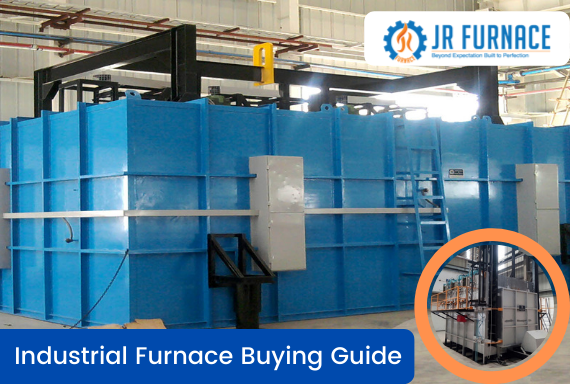
The various factors that need to be considered when purchasing a new furnaces/ovens. Read our Furnace Buying Guide 2020. They are listed below:
- Operating Temperature
- Furnace Size
- Uniformity, Heating Media, Access
- Furnace Atmosphere
- Furnace Controllers, Data Loggers and Computer Interfaces
- Aesthetics
Furnaces will come in all shapes and sizes, as the need for specialization has led to model differentiation and abundance.
This quick Furnace Buying Guide will help you go through a couple of basic consideration steps that will help you narrow down your possible selections to the Heat Treatment Furnace that meet your practical requirements as well as technical performance expectations.
Size and Volume
How Big Does the Furnace Need to Be?
First and foremost, consider the space requirements for your Furnace chamber. Consider the size and charge load that must go into the Furnace. At JRFurnace we will ask you the required internal dimensions for the furnace.
Working out the internal dimensions for your oven or furnace is fairly simple. As a general rule, if you don’t know what size the furnace needs to be, take the largest product that is going to go into the furnace and add 100mm on each dimension.
For example, if you product is 500x500x500mm, you are going to need an oven 600x600x600mm. Don’t forget to consider the loading technique for the product. Eg. Additional space for bogie/trolleys etc. If your furnace/oven needs to be calibrated with temperature uniformity (eg. +/- 5) then this area would need to be expanded by approx. 400mm. Therefore the Calibrated area would be 600x600x600mm, whereas the actual chamber dimensions would be 1000x1000x1000mm.
If you don’t know the size of the furnace required but you do know the product size just send this to us and we will do the working out for you.
Type and Application
Each heating purpose has its own furnace sub-type. Different industrial furnaces are ideal for different applications, so first clarify what you need the furnace for like Bogie , Chamber, Pusher and etc and applications like annealing, ageing, hardening, tempering and etc.
Batch Furnaces are useful for when working with product batches in predetermined heating settings, while continuous furnaces maintain a specified environment that is valuable to the target result.
Temperature Requirements
What Temperature Does Your Process Require?
From ambient to many hundreds of degrees Celsius, the maximum temperature of a Heat Treatment Furnace ranges greatly. Depending on the materials you are planning to put in there, the amount, and the desired heating levels and heating times, you will have to consider the minimum required temperature. The best way to get an accurate price is to find out the exact temperature required.
An oven will run from ambient up to 450°C whereas a furnace will run from 500°C to 1400°C.
Once an oven reaches approx. 350°C the internal lining will need to be changed from aluminized steel to stainless steel, therefore you will see a significant price increase.
For example, the price difference between 100°C and 200°C would be negligible, whereas the price difference between 350°C and 450°C would be substantial.
Therefore, it’s always best to know what is required. However, if you don’t know, more often than not, depending on the process and materials, we will be able to point you in the right direction.
Temperature Uniformity
Some standards such as AMS2750E (used within the Aerospace industry) call for furnaces and ovens to be calibrated to function within a certain temperature range. For example 250°C +/- 3°C.
All of our furnaces will have a certain element of uniformity (approx. +/-5°C to +/-10°C) as standard. All the above means is that the furnace will be calibrated and certified to your chosen standard.
If a batch is unevenly heated, it may mean getting defective products. At JR Furnace we are familiar with all the industry standards and have vast experience designing and manufacturing ovens to suit.
In case more uniformity is needed, for lower temperature units, approx. 700°C or lower, stirring fans or recirculating air heating systems will be needed.
For higher temperatures a larger furnace is required in order to achieve the required temperature uniformity or “flat zone”, a different heater configuration may be suggested or multiple heat zones may need to be added. The design requirements are specific to the user’s uniformity and operating requirements.
Energy Saving Insulation
The thermal insulation of the doors and walls of the furnace are also vital on that part, as leaking the generated heat out of the chamber is wasted energy so we suggest for energy saving insulation.
Access
Where Does the Door Need to be?
As standard furnace will have a manually operated, single hinged door to the front.
Double Hinged Doors – We can provide double doors where a single door would take up too much space when opened.
Vertical Hydraulic Doors – We can provide with a hydraulically operated vertical door. Ideal in situations where space is tight and in larger applications.
Sliding Hydraulic Doors – We can provide with a hydraulically operated sliding door. Ideal in situations where space is tight and in larger applications. Also available in double configuration.
Heating Media
Electric or gas-fired are the most common, however, we are experienced with thermal fluid, steam, oil-fired and indirect gas-fired.
The heating media required really depends on the facilities on site therefore the more we know at enquiry stage, the more accurately we can price a furnace/oven with the most economical heating media for you to run.
Ready to choose the right Industrial Furnaces? Or maybe you need more help finding the perfect Industrial Furnaces and ovens? Get answers to your questions and more by calling Sales Manager at +91 7604915438
